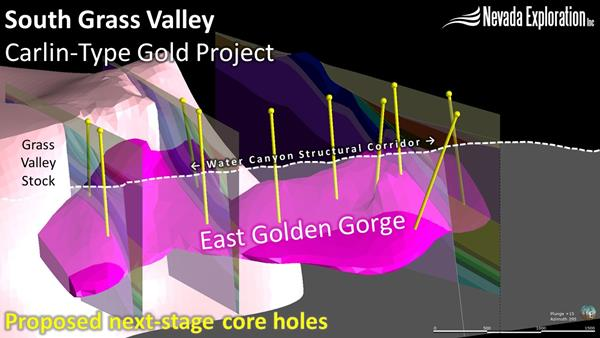Jul 14 2020
Nevada Exploration Inc. recently announced its next-stage plans for advancements to the East Golden Gorge target at its district-scale South Grass Valley Carlin-type gold project.
 Proposed next-stage core holes at East Golden Gorge. Image Credit: Nevada Exploration Inc.
Proposed next-stage core holes at East Golden Gorge. Image Credit: Nevada Exploration Inc.
The target hosts the intersection of a range of high-angle, regional-scale faults dubbed the Water Canyon structural corridor by Nevada Exploration, as well as a Cambrian-aged limey mudstone (the “Clm Unit”). Nevada Exploration considers that these faults together represent the dominant primary and secondary controls for the hydrothermal fluids that have led to the mineralization observed in its drilling so far.
For East Golden Gorge advancement, Nevada Exploration has designed a 10-hole, 12,500-m core drilling program to investigate for potentially-economic mineralization along a 3,500-m length of the target.
Nevada Exploration has prepared a video highlighting the major geologic features at the project to share how it is narrowing its search for Carlin-type gold mineralization in East Golden Gorge, explaining why the outcomes of its latest study have led Nevada Exploration to East Golden Gorge. The company has also laid out its next-stage plans to advance the project.
James Buskard, President of Nevada Exploration Inc., thus discusses the company’s plans for East Golden Gorge: “When we review the results of our two drilling programs as a whole, what we’re seeing at South Grass Valley is a typical Carlin-type geologic setting with characteristic alteration and anomalous geochemistry across several cubic kilometres of bedrock, which remains open.”
By integrating the results of our drilling and mapping with the data from our geophysical surveys we believe we have established the primary source for the mineralized hydrothermal fluids responsible for these Carlin-type features, namely the Water Canyon structural corridor. Based on the intensity and zonation of the alteration, gold, and pathfinder concentrations there is strong evidence that the secondary, lateral movement of the fluids through the district was stratigraphically-controlled within the Clm Unit.
James Buskard, President, Nevada Exploration Inc.
“With a handle on what we think are both the primary and secondary controls for the mineralized hydrothermal fluid flow through the district, our focus has narrowed to where the Clm Unit dips closer to the Water Canyon structural corridor, representing the geologically-constrained target called East Golden Gorge,” added Buskard.
Buskard continued, “To test East Golden Gorge for Carlin-type mineralization we’re proposing a program of carefully-targeted core holes to sample the full thickness of the Clm Unit along a three-and-a-half-kilometre length of the target. As we plan this ambitious drilling program, we want to highlight what differentiates the target from other early-stage projects in Nevada.”
“Most significantly, compared to the size of the mineral systems hosting some of Nevada’s largest deposits at the north end of the valley, we believe the size of the target and scale of its associated alteration features support the potential to discover an entire new district,” Buskard noted.
Our next-stage program is designed to test for both a flat-lying geometry similar to that of Goldrush, in our case associated with stratigraphic-hosted mineralization within the Clm Unit, as well as more-vertical-hosted mineralization, similar to that at Cortez Hills, associated with the breccia features we’re seeing and the margins of the Grass Valley Stock.
James Buskard, President, Nevada Exploration Inc.
Buskard explained, “To ensure the spacing of our proposed holes is suitable to test for this more-vertical type orientation, we’ve placed them an average of 600 metres apart along the length of the target. As we continue to advance and de-risk this district-scale target, we believe strongly that in today’s covered search spaces geology is what is drives discoveries.”
“From the beginning, we’ve taken a systematic approach to building the geologic framework we’re now using to target mineralization based on the latest research on the features and processes responsible for Nevada’s largest Carlin-type gold districts, as well as by integrating new exploration tools,” noted Buskard.
This is the exact geology-driven process being used by the world’s largest mining companies, and we believe based on our results to date, that we have the opportunity here at South Grass Valley to make a significant discovery, at a completely covered and otherwise blind project, that we discovered as a result of our industry-leading groundwater chemistry exploration program.
James Buskard, President, Nevada Exploration Inc.
South Grass Valley Project
The South Grass Valley project of Nevada Exploration is a covered, or blind, gold exploration project situated about 50 km south-southwest of the Cortez complex, which is being run by Nevada Gold Mines (Barrick Gold Corp. and Newmont Mining Corp. joint venture) and Barrick Gold Corp.’s latest Fourmile discovery, inside the particular region of north-central Nevada hosting Nevada’s largest Carlin-type gold deposits (CTGDs).
The project was originally identified and staked by Nevada Exploration based on increased concentrations of gold and CTGD pathfinder elements in groundwater identified as part of a generative basin-scale hydrogeochemistry-supported exploration program.
From the time Nevada Exploration acquired the Project, the company has completed the following: detailed air magnetic and gravity geophysics surveys, an infill borehole groundwater sampling program, a series of stratigraphic orientation diamond core holes, a soil geochemistry sampling program, and most recently (2020), several wide-spaced reverse-circulation drill holes to enhance the density of its bedrock sampling.
As explained in the technical video and Nevada Exploration’s news release dated May 27th, 2020, based on the outcomes of its combined exploration datasets, the company considers it has identified a district-scale Carlin-type mineral system of a scale required to host a completely new district. It will now focus its exploration efforts at a particular target named East Golden Gorge.
With continuous efforts to advance the East Golden Gorge Project, Nevada Exploration must keep its stakeholders informed that the project is still an exploration target for which the potential grade and quantity of any mineral resource is conceptual, and that it is not sure if additional exploration will lead to the delineation of the target as a mineral resource.